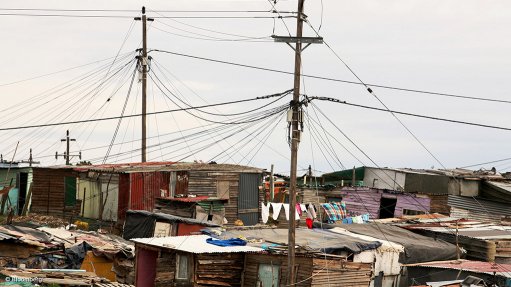
ENERGY POVERTY Sustainable Energy Africa enables municipalities to implement sustainable energy strategies
Local governments, as key decision-makers in urban development and planning, need to be more involved in the development of a sustainable energy sector, says research organisation Sustainable Energy Africa (SEA) director Mark Borchers.
He notes that energy is an essential facet of sustainable development and is closely linked to welfare, economic health and environmental sustainability, which are important functions of local governments. Additionally, muni- cipalities’ core roles, such as urban and transport planning, and building plan approvals, are important factors in energy transitions and impact significantly on national energy profiles.
Borchers states that municipalities have an important facilitative role to play in national programmes that promote sustainable energy, specifically ones concerning energy efficiency, as such programmes that will benefit from local officials’ knowledge of the region and their links within a local community. They can also monitor the implementation of the programmes and intervene if necessary.
In addition, municipalities often have direct ownership and control of their own building stock, vehicle fleet, waste collection and sewage processing, which provide opportu- nities to demonstrate energy efficiency interventions or potentially generate renewable electricity from landfill gas and sewage methane.
Borchers believes that municipalities should also play a facilitative role in small-scale decentralised renewable-energy generation, such as rooftop solar photovoltaic generation, thereby decreasing demand on the national grid.
South African municipalities have little to no input in the Renewable Energy Independent Power Producer Procurement Programme (REIPPPP), even though they benefit indirectly from it in terms of local job creation and increased economic stimulus, states Borchers. He suggests that municipalities could facilitate the REIPPPP process by assisting in land negotiations or expediting environmental-impact assessments.
“Collaboration between national and local government will allow for more effective planning, and create innovative and locally appropriate approaches, which centralised planning rarely produces,” he states.
Borchers notes that there is exponential population growth in small and medium-sized urban centres, particularly in sub-Saharan Africa, explaining that “this is important because, while the capacity of Africa’s large-city municipalities is generally insufficient to meet growing service-delivery demands, the capacity shortage in the smaller urban centres is much more severe”.
Therefore, addressing challenges associated with sustainable energy will require specific capacity building and support, as well as changes in institutional approach and mindsets, which SEA is attempting to address.
Meanwhile, the Supporting Sub-Saharan Municipalities with Sustainable Energy Transitions (Samset) project is a multiyear endeavour, led by SEA, which supports six pilot municipalities in Ghana, Uganda and South Africa to develop and implement sustainable energy strategies.
The Samset project is based on a model deve- loped in South Africa that has been supporting municipalities over the past 15 years. Polokwane and Cape Town are the cities that have benefited from the project, which develops an overarching strategy for providing affordable and sustainable energy, tailored to fit the munici- palities’ financial, legal and environmental restrictions.
“Empowering local government to support the sustainable energy agenda will diversify energy-sector governance, which, in turn, introduces more innovation and robustness in the sector,” Borchers remarks.
A key challenge for South African municipa- lities is the potential loss of electricity revenue, as a result of increased decentralised, privately owned small renewable-energy installations and energy efficiency interventions.
SEA, with funding from clean energy organisation Renewable Energy and Energy Efficiency Programme, embarked on a year-long project that developed an accurate model to determine municipal revenue losses, owing to the uptake of energy efficiency and renewable energy over a period of ten years.
This increase in renewable-energy generation and efficiency projects is primarily because of steeply rising electricity prices from State-owned power utility Eskom and municipalities, although agendas such as climate change have also influenced this trend.
SEA senior project coordinator Simisha Pather-Elias notes that “though the shift is essential for national and global economic and environmental sustainability reasons, this currently has a negative financial impact on the municipalities that depend on electricity sales as a source of revenue”.
She elaborates that, for most municipalities, these sales are the largest source of income – a decrease in income can have profound effects on their ability to deliver services and cross- subsidise poor customers.
Municipalities are expected to supplement the grants they receive from national government through rates and the sale of electricity and water to fund other expenditures, such as infrastructure build and maintenance, she states.
Pather-Elias explains that, “since it is the mid- to high-income residential sector, as well as commercial and industrial sectors that are most likely to install decentralised private renewable-energy systems and energy efficient technologies, reduced sales in these sectors result in reduced funds to cross-subsidise basic services, including electricity for indigent households”.
Borchers believes that, while this could become a cause of concern for municipalities, it is being addressed by changing the tariff structure to ensure that revenue is protected to some extent.
“Renewable-energy costs are falling stea- dily and a large increase in decentralised systems seems inevitable in the longer term. Thus, characteristics of future energy systems are likely to look completely different to the current systems and, as such, energy planning needs to adapt. Internationally, some analysts are saying that the era of big utilities is drawing to a close,” he concludes.